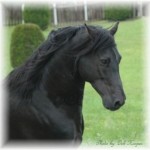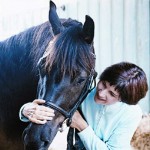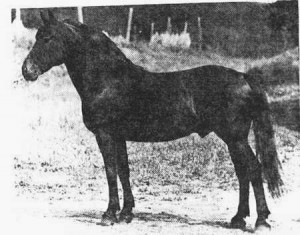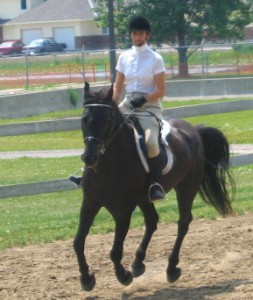
Breed History
Roxanne Salinas of British Columbia has done extensive work on the history of the Canadian horse. Her research has taken her to Ontario and Quebec, and she’s explored the digital collections of the national archives of Quebec and France. During this research, she met another passionate fan of the breed, Élène Sergerie of Joliette, QC. Together on the Internet they spent many long winter evenings exploring the history of the breed, sharing discoveries and helping each other with translating old stories in English and French.
When I learned that Roxanne and her husband would no longer be breeding Canadians and were going to cancel their website, she graciously gave me permission to move her pages over to my site. They’re too good to be lost! Click here to discover the fascinating history of Canada’s National Horse: Legacy Canadians resource pages
Swallowfield Eno Kelbeck
Re the gorgeous stallion, above, Roxanne says, “I first saw Eno, sire of Kelbeck (Kal), in the summer of 2000; he died that winter. He was out with two mares and foals, and one of those foals was Kelbeck. We went into the pasture to see the mares and Eno walked out from behind a grove of trees.He held himself so proudly, and he looked right at me with a look that was strong and confident yet showed a stoic and wise old soul—one of those moments that is forever embedded in memory. I’d looked at quite a few Canadians already but Eno stood out to me with a presence the others didn’t have.
“I mentioned to Eno’s owner that I would like an Eno son one day, so when we returned that fall to buy a mare, we managed to stuff Kelbeck—who was a fuzzy, un-halter-broke weanling—in the trailer too and we brought him home.” Kelbeck went on to do brilliantly in dressage, showing off the athleticism and calm temperament of the Canadian horse.”
While it was difficult to part with Kelbeck, keeping a stallion is not an easy task, and Roxanne can take comfort in knowing he’s gone to a breeder who’ll ensure that Eno and Kelbeck’s genes are passed on to future generations of the Canadian Horse.

Mainguy Bismark Joé (Beau)
I was lucky enough to own a Canadian for four years. Then fate intervened and I had to sell him. But before that, I wrote this piece for a magazine about my love affair with the breed:
Love at First (Canadian) Sight
Although I’ve been around the block a few times, I’ve yet to fall in love with a man at first sight. I did, though, fall that way for a horse. Not only that, I fell for a dead horse. What I mean is, the horse came in the form of a small black-and-white photo, circa 1930, that I found on the Internet. He took my breath away.

He was a Canadian stallion, a prominent sire in his day. I’d first heard of the breed 25 years ago, from a horseman who told me that they were close to extinction. I’d always been horse-crazy and I’d owned a horse as a kid, so I was curious to know more and see a Canadian in the flesh. But back then I was a folk musician, too busy and too poor at the time to get back into horses. More than a decade would pass before I could allow equine dreams into my life. Eventually I started riding once more and began to think about buying a horse. Someone mentioned Canadians again, so I searched them out on the Web.
And there he was. His name was Laurent de Cap Rouge, and I still can’t fully articulate what it was that made me fall so hard, because he wasn’t flashy. Maybe it was the proud head carriage, the kind eye, the alert and intelligent expression. Maybe it was his solid, compact, curvy build (forget those long, lean creatures – I’ve always been a sucker for Baroque breeds). But there was something more going on. Perhaps it had to do with my Quebecois roots, because Laurent seemed … familiar. It was as though I’d known this horse in a past life.

Fortunately Canadians are no longer close to extinction, though they are rare (the breed numbers about 6,000 currently). As I began to research the breed, the more I learned, the more I got hooked. I’m a real nationalist, so the Canadian’s romantic history appealed to me. Descended from horses King Louis XIV sent to New France in the mid-1600s, the Canadian, known as “the Little Horse of Iron,” adapted through centuries to become hardy, versatile, calm and low maintenance, with excellent feet – all things that mattered in my limited-budget middle age.
Plus, they come in smaller sizes; I wanted a horse I didn’t need a ladder to mount. In Quebec I found and bought, with uncharacteristic impulsiveness, a 15-hand, three-year-old gelding named Mainguy Bismark Joé, whom I nicknamed Beau.
Suffice to say it’s been an adventure. I’d never dealt with a young horse before, especially not a smart, strong-willed one! But I don’t regret a minute of it, and now that Beau is almost seven, he’s matured. He’s the best horse I’ve ever ridden out on trails: sensible, eager, brave, and perfectly happy to go out alone. He has a trot to die for. He learns tricks in a minute and he’s more bilingual than most of my friends. And every time Beau stands alert, ears pricked forward, he takes my breath away, and I get that feeling I got when I first saw the picture of Laurent de Cap Rouge – somehow, in some deep mysterious way, this breed and I are connected.
MORE LINKS
Canadian Horse Breeders Association: http://www.lechevalcanadien.ca
Want to buy your own Canadian?! http://www.canadianhorselink.com



